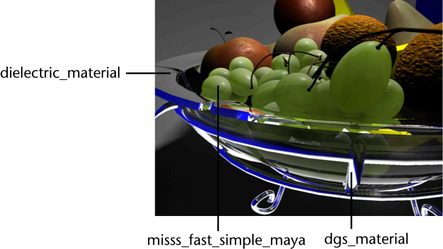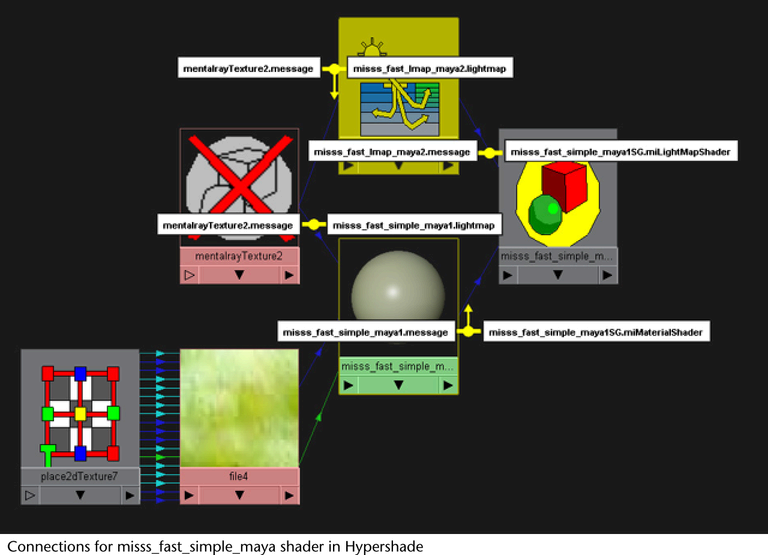dielectric_material node
In this scene, the bowl
is created using the dielectric_material shader.
This shader is commonly used for dielectric media such as glass,
water, and other liquids.
Sample workflow for dielectric_material
- Open the Hypershade editor.
Under the Create tab, select Create
mental ray Nodes. Click on dielectric_material under
the Materials section to create
the shader.
- In the shader’s Attribute
Editor, change Index of Refraction to
1.65. This is the index of refraction for a typical glass material.
- Click on the dielectric_material1SG node.
In the Attribute Editor, expand the
mental ray section. Since photons are used in this scene (for caustics and
global illumination, and so on), a photon shader needs to be added to
the shader group. Under the Custom Shaders section,
click for the Photon
Shader attribute and select dielectric_material_photon (under
the Photonic Materials section).
This is the corresponding photon shader for the dielectric_material shader.
- In the Attribute Editor,
change the Index of Refraction for the dielectric_material_photon to
also be 1.65. In this scenario, we wish to simulate both the appearance
of glass and the caustic effect of glass. Therefore, the Index
of Refraction for the dielectric_material and dielectric_material_photon shaders
are set to identical values.
dgs_material node
The stand of the bowl
is created using the dgs_material shader. This shader is commonly
used to simulate glossy materials such as metals, mirrors, glossy paint
and plastic, and so on.
Sample workflow for dgs_material
- Open the Hypershade editor.
Under the Create tab, select Create
mental ray Nodes. Click on dgs_material under
the Materials section to create
the shader.
- Click on the dgs_material1SG node. In
the Attribute Editor, expand the mental
ray section. Since photons are used in this scene (for caustics
and global illumination, and so on), a photon shader needs to be
added to the shader group. Under the custom shaders section, click
 for the Photon Shader attribute
and select dgs_material_photon (under
the Photonic Materials section).
This is the corresponding photon shader for the dielectric_material shader.
for the Photon Shader attribute
and select dgs_material_photon (under
the Photonic Materials section).
This is the corresponding photon shader for the dielectric_material shader.
Subsurface scattering node
The grapes in this scene
are created using the subsurface scattering node. Subsurface scattering
is usually used to create materials that scatter or absorb light
internally (rather than reflect light at the surface). Using subsurface scattering,
the grapes in the scene appear translucent and glowing.
mental ray for Maya includes
several subsurface scattering nodes, for example, misss_physical,
misss_fast_shader, misss_skin_specular,
and so on.
misss_physical simulates
subsurface scattering in the most realistic and physically accurate
way. Alternatively, misss_fast_* provides a reasonable simulation
of subsurface scattering, but allows for more efficient rendering
and is easier to set up.
Sample workflow for misss_fast_simple_maya shader
- Open the Hypershade editor.
Under the Create tab, select Create
mental ray Nodes. Click on misss_fast_simple_maya under
the Materials section to create
the shader.
- Since subsurface scattering involves
the bouncing of light near the surface, a lightmap must be attached
to the shader. In the Hypershade editor,
click misss_fast_lmap_maya under
the Light Maps section to create
the lightmap shader.
- Click on the misss_fast_lmap_maya shader
node. In the Attribute Editor, expand the Lightmap
Write section and click
 for the Lightmap attribute
to create a texture node.
for the Lightmap attribute
to create a texture node.
- In texture node’s Attribute
Editor, check Writeable.
Change the Filter Size Width and Filter
Size Height to your render size. Change File
Size Depth to 32 bits. Enter a file name in the Image
Name attribute.
- Click on the misss_fast_simple_maya material
and map the misss_fast_lmap_maya shader
to its Lightmap section.
- Increase the number of samples in the Lightmap section
to create a smoother effect. Increasing the number of samples would
create more scattering and increase the intensity of the light gather
effect. The scene thus has more glow.
- Tweak the values under Algorithm control
for better results.
TipBeginning in Maya
8.5, you can also get the look of subsurface scattering in your
scene by tuning the scatter attributes available in the mental ray
section of the
Anisotropic,
Blinn,
Lambert,
OceanShader,
Phong and
PhongE surface
material nodes. For more information regarding these scatter attributes,
see
Scattering and
Work with Scattering.


 for the Photon Shader attribute
and select dgs_material_photon (under
the Photonic Materials section).
This is the corresponding photon shader for the dielectric_material shader.
for the Photon Shader attribute
and select dgs_material_photon (under
the Photonic Materials section).
This is the corresponding photon shader for the dielectric_material shader.
 for the Lightmap attribute
to create a texture node.
for the Lightmap attribute
to create a texture node.
